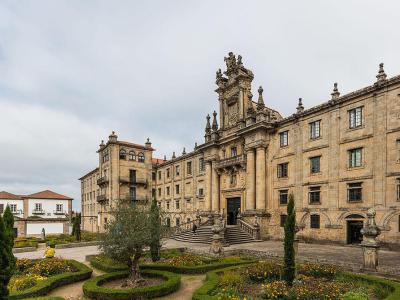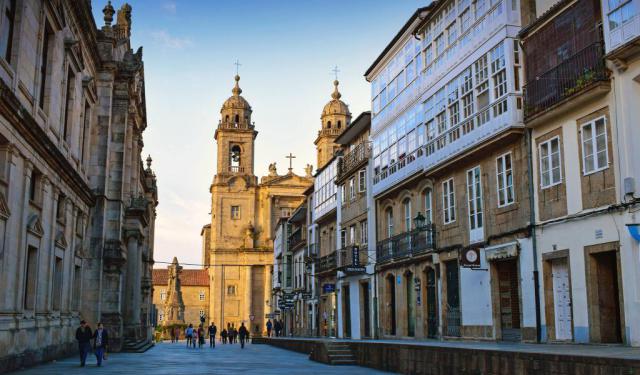
Monasterio de San Martin Pinario (Monastery of San Martino Pinario), Santiago de Compostela (must see)
The Monastery of San Martiño Pinario holds a significant place in the region's history. While little remains of the original medieval structures, the monastery has been rebuilt since the sixteenth century and continues to be an important landmark in the city. It is the second largest monastery in Spain, surpassed only by San Lorenzo de El Escorial.
The origins of the monastery date back to around the year 899 when it was built on the site of a chapel called Corticela, dedicated to Santa Maria. The chapel was a part of the Santiago de Compostela Cathedral, but when Alfonso III of Asturias and Bishop Sisnando began constructing a new cathedral, the Benedictine monks moved to the new monastery. A later monastery was built to replace the original one, and its church was consecrated in 1102 by Bishop Diego Gelmírez. However, little remains from that era.
During the Middle Ages, the Monastery of San Martiño Pinario grew in power and wealth, becoming the richest and most influential monastery in Galicia by the end of the fifteenth century. This led to significant reconstruction efforts starting in the sixteenth century. The monastery gained control over most of the monasteries in Galicia and held immense influence in the region.
The construction of the current church began in the late sixteenth century, under the guidance of Archbishop Juan de Sanclemente Torquemada and the architect Mateo López. After López's death in 1606, Benito González de Araujo took over the project. The church's facade faces west, opening to the square of San Martín. It features a magnificent altarpiece structure made of stone, divided into three sections and adorned with fluted columns. The main dedication of the church is to the Virgin Mary and the Benedictine order.
The origins of the monastery date back to around the year 899 when it was built on the site of a chapel called Corticela, dedicated to Santa Maria. The chapel was a part of the Santiago de Compostela Cathedral, but when Alfonso III of Asturias and Bishop Sisnando began constructing a new cathedral, the Benedictine monks moved to the new monastery. A later monastery was built to replace the original one, and its church was consecrated in 1102 by Bishop Diego Gelmírez. However, little remains from that era.
During the Middle Ages, the Monastery of San Martiño Pinario grew in power and wealth, becoming the richest and most influential monastery in Galicia by the end of the fifteenth century. This led to significant reconstruction efforts starting in the sixteenth century. The monastery gained control over most of the monasteries in Galicia and held immense influence in the region.
The construction of the current church began in the late sixteenth century, under the guidance of Archbishop Juan de Sanclemente Torquemada and the architect Mateo López. After López's death in 1606, Benito González de Araujo took over the project. The church's facade faces west, opening to the square of San Martín. It features a magnificent altarpiece structure made of stone, divided into three sections and adorned with fluted columns. The main dedication of the church is to the Virgin Mary and the Benedictine order.
Want to visit this sight? Check out these Self-Guided Walking Tours in Santiago de Compostela. Alternatively, you can download the mobile app "GPSmyCity: Walks in 1K+ Cities" from Apple App Store or Google Play Store. The app turns your mobile device to a personal tour guide and it works offline, so no data plan is needed when traveling abroad.
Monasterio de San Martin Pinario (Monastery of San Martino Pinario) on Map
Sight Name: Monasterio de San Martin Pinario (Monastery of San Martino Pinario)
Sight Location: Santiago de Compostela, Spain (See walking tours in Santiago de Compostela)
Sight Type: Religious
Guide(s) Containing This Sight:
Sight Location: Santiago de Compostela, Spain (See walking tours in Santiago de Compostela)
Sight Type: Religious
Guide(s) Containing This Sight:
Walking Tours in Santiago de Compostela, Spain
Create Your Own Walk in Santiago de Compostela
Creating your own self-guided walk in Santiago de Compostela is easy and fun. Choose the city attractions that you want to see and a walk route map will be created just for you. You can even set your hotel as the start point of the walk.
Santiago de Compostela Introduction Walking Tour
Legend has it that after Saint James, one of the Twelve Apostles of Jesus, was martyred in Jerusalem in 44 AD, his followers carried his decapitated body by sea to Spain. Others claim that the saintly remains were miraculously taken up by angels and sailed to the coast of Galicia, where a massive rock closed around it and was later moved to its final resting place.
Either way, during the... view more
Tour Duration: 2 Hour(s)
Travel Distance: 1.7 Km or 1.1 Miles
Either way, during the... view more
Tour Duration: 2 Hour(s)
Travel Distance: 1.7 Km or 1.1 Miles

